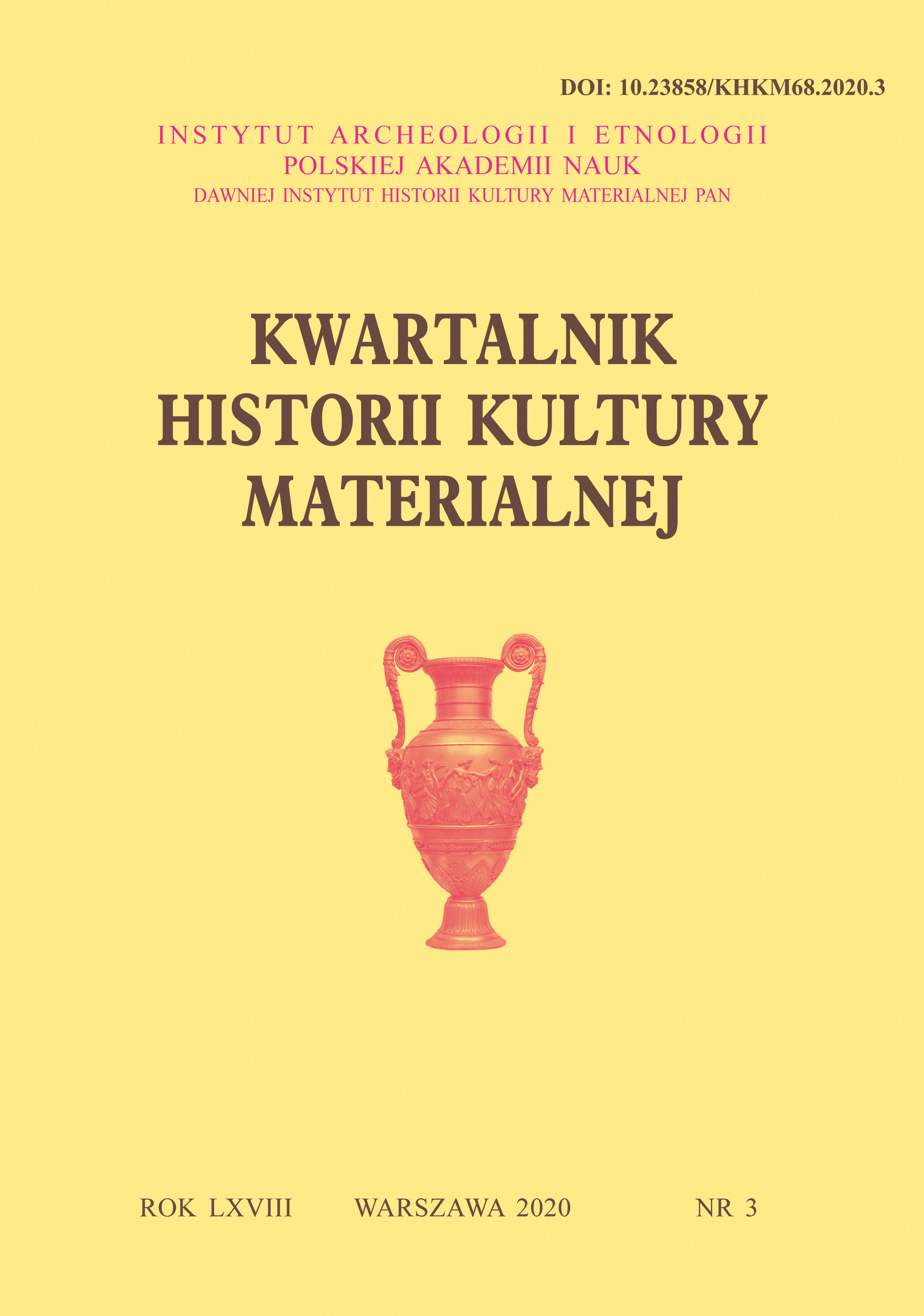Two unpublished mediaeval anthropomorphic knife handles from the National Museum in Cracow
DOI:
https://doi.org/10.23858/KHKM68.2020.3.006Keywords:
anthropomorphic handles, fourteenth century, Poland, CracowAbstract
The article is the first publication on two mediaeval anthropomorphic knife handles from the collection of the National Museum in Cracow, never described in the literature so far. One of them shows a man feeding with his left hand a falcon sitting on his right arm (fig. 1). This item has no archaeological context. The other artefact shows a woman holding in her hands an object which is usually interpreted as a book, or less frequently as a box (fig. 2). Both motifs, especially the former one, are often found in knife handles and hair parters dating from between the 2nd half of the 13th and the 14th c. Considering the style of the man’s headgear, the first item can be assumed to have been made in the first half of the 14th c. The other handle can be dated broadly to the 14th c.; and it is more interesting to investigate. It was found in Cracow at the end of the 19th c., during construction works. It had not been finished: there is unworked raw material at the bottom of the figure. The carving of this artefact was abandoned as it had cracked lengthwise. This find proves that handles of that type were made not only in Western Europe, as is widely assumed, but also in Central Europe, including Poland.
Downloads
References
Bayard Didier, Mantel Etienne. 1989, La maison forte de “La Cologne” a Hargicourt (Aisne). Etude du mobiler, „Revue Archeologique de Picardie”, nr 3–4, s. 141–182.
Bencard Mogens. 1975. Om et middelalderligt knivskaft fra Ribe, [w:] Fra Ribe Amt, t. 19: Festskrift til H. K. Kristensen, Ribe, s. 35–61.
Caune Andris. 1973. Raboty rižskoj ekspedicii, [w:] Acheologičeskie otkrytija 1972 goda, Moskva, s. 394–396.
Caune Andris. 2009. Archäologische Zeugnisse von den Kontakten Rigas mit den westeuropäischen Ländern und Alt-Russ im 13.–14. Jh., [w:] The Hansa Town Riga as mediator between East and West, red. A. Caune, I. Ose, Riga, s. 19–27.
Codex Manesse. 2017. Codex Manesse, Universitätsbibliothek Heidelberg, digi.ub.uni-heidelberg.de/digit/cpg484/ (dostęp 02.09.2017).
Holtmann Gerhard Folke Wulf. 1993. Untersuchung zu mittelalterlichen und frühneuzeitlichen Messern, Göttingen.
Howe Martin D. 1983. A medieval Knife Handle from Crowland, Lincolnshire, „Medieval Archaeology”, t. 27, s. 146–150.
Kowalczyk-Heyman Elżbieta. 2010. Anthropomorph verzierte mittelalterliche Messergiffe in Polen, „Questiones Medii Aevi Novae”, vol. 15, s. 241–282.
Kowalczyk-Heyman Elżbieta. 2014. Znalezisko kolejnej średniowiecznej rękojeści antropomorficznej w Polsce, „Kwartalnik Historii Kultury Materialnej”, R. LXII, nr 4, s. 625–635.
Kowalczyk-Heyman Elżbieta. 2017. Kilka uwag o warsztacie naukowym na podstawie artykułu o średniowiecznym nożu z rękojeścią antropomorficzną ze Szczecina, „Kwartalnik Historii Kultury Materialnej”, R. LXV, nr 4, s. 507–512.
Leciejewicz Lech. 1974. O pochodzeniu rogowej rzeźby ze Wzgórza Zamkowego w Szczecinie, [w:] Studia Archaeologica Pomeranica, red. F. Lachowicz, Koszalin, s. 177–188.
Marcinkowski Mirosław. 2005/2006. Człowiek ukryty w kości — średniowieczne rzeźbione rękojeści noży z Elbląga na tle europejskim, „Materiały Zachodniopomorskie. Nowa seria”, t. II/III, z. 1, s. 359–373.
Ose Ieva. 2008. Einige Zeugnise vom Lebensstil der reichen Bürger in Riga im 13.–15. Jahrhundert, [w:] Lübecker Kolloquium zur Stadtarchäologie im Hauseraum, [t.] VI: Luxus und Lifestyle, Lübeck, s. 569–583.
Roeder M. 2016. Der mit dem Falken jagt, „Archäeologie in Deutschland”, z. 2, s. 41.
Rybina Elena Aleksandrovna. 2001. Frühe ‘Joint Ventures’. Die Beziehungen Novgorods in Ostseeraum, [w:] Novgorod. Das mittelalterlische Zentrum und sein Umland im Norden Russlands, Studien zur Siedlungsgeschichte und Archäologie der Ostseegebiete, t. 1, red. M. Müller-Wille i in., Neumünster, s. 291–308.
Sommerard Edmond du. 1883. Catalogue et desccription des objets d’art de l’antiquité du moyen âge et de la Renaissance, exposées au Musée de Cluny, Paris.
Wachowski Krzysztof. 2013. Emblemata mediaevalia profana. Przykład Polski, Wrocław.
http://cartelen.louvre.fr/cartelen/visite?srv=car_not_frame&idNotice=28724&langue=en (dostęp 31.05.2013).
https://www.facebook.com/Eileandonancastle1/posts/10155025945787888:0 (dostęp 21.07.2017).
http://www.gothicivories.courtauld.ac.uk/ (dostęp 30.03.2012-21.07.2017).
https://zbiory.mnk.pl/pl/wyniki-wyszukiwania?phrase=sztylet (dostęp 14.05.2020).



 Publication co-financed by the Ministry of Science and Higher Education under the program "Support for scientific journals 2019-2020"
Publication co-financed by the Ministry of Science and Higher Education under the program "Support for scientific journals 2019-2020"










